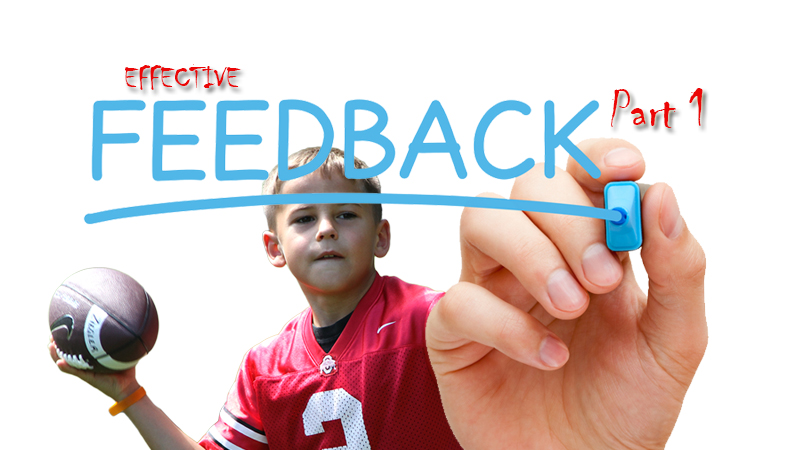By Craig Valency, MA, CSCS
After teaching a movement skill, how many times have you heard yourself say, “Great job!” “Well done.” “Nice try!” “Good girl!” and of course, “Attaboy!”?
Ahem – I’m guilty as charged; way too many times!
We spend so much time perfecting how we teach that it’s easy to forget the power of effective feedback on every lesson. After doing a stellar job of teaching a tough movement skill such as a hip hinge or overhand throw, it is easy to fall into the trap of giving reflexive, lazy feedback.
Effective teaching and coaching techniques are only half of the equation when it comes to helping children master skills at their appropriate developmental level. Before and after you spend time teaching a lesson, the amount and type of feedback that is given can have very influential effects on the acquisition of a skill. Feedback can also have a lasting impact on a child’s self-regulation, self-worth, enjoyment, and future participation in physical activities. Feedback is crucial!
The Feedback Cycle
Hattie and Timperley (2007) have proposed a comprehensive model of feedback in the context of academic learning in the classroom, which can be successfully applied to the improvement of movement skills (p. 87). The feedback cycle proposes a method of first priming the student by setting up a goal (feed up), then providing specific information about the performance of that goal (feed back), and finally, reviewing outcomes and discussing the next steps of where this would lead, in terms of larger objectives (feed forward).
Effective feedback should address the three phases of the feedback cycle:
1. Feed Up: Where am I going right now?
This is the point where a clear goal, or the criteria for success, must be defined, and the student should know when and how to achieve it. Feed up takes place immediately before the activity. This is where we give a child the lens through which they should view the activity. The feedback must relate to the specific goal or cue that is put forth, no matter what other problems or challenges the student may demonstrate during the task. Goals are most effective when the students are truly committed to achieving them. Hattie and Timperley point out the power of role models and peers to positively influence a child’s commitment to the goals.
2. Feedback: How am I doing?
This is the actual “feedback” part of the model, where an authority figure, peer, or the child (self) provides objective information relative to the specific goal of the task during, or immediately following, the activity. This level is effective when it conveys specifics regarding the status of progress and/or how to proceed.
3. Feed forward: Where will I go from here?
This phase of the model can have some of the biggest impacts on learning, as it directs the student to the next step in the process of learning skills. This phase takes place immediately following the activity. Here we revisit the purpose. The child should know why they just did what they did, then use the data and/or observations to plan the next steps. It is important to explain the next steps to the child. The child should then be able to retell the next steps in his or her own words. Skill acquisition necessarily builds on itself, so having successive goals will direct students to see the big picture and bring purpose and meaning to the skill progression. This can create more buy-in and intrinsic motivation.
Being intentional about feedback has dramatic results on how children learn and retain skills. Understanding the feedback cycle is the first step in teaching and extending new skills. In part 2, “The Feedback Flow,” I’ll talk about the most effective forms of feedback as well as types of widely used feedback that are not only ineffective but that can actually be damaging.
References:
Graham, G., Holt/Hale, S., & Parker, M. (2013). Children Moving: A reflective approach to teaching physical education (Ninth ed.). New York: McGraw-Hill.
Gallahue, D., & Cleland Donnelly, F. (2003). Developmental Physical education for all children (Fourth ed.). Champaign: Human Kinetics.
Hattie, J., & Timperley, H. (2007). The Power of Feedback. Review of Educational Research, 77(1), 81-112.
Higgins, S. (2011). Formative assessment and feedback to learners. Better: Evidence-based Education, 8-9.
Craig Valency, MA, CSCS, president and co-founder of SPIDERfit, has been a personal trainer for the last 11 years. He is currently working at Fitness Quest 10 in San Diego, an elite personal training and athletic conditioning facility. He specializes in youth strength and conditioning programs that promote physical literacy, injury prevention and optimal performance. Along with training youths from 6 to 18 years of age for general fitness, Craig has also worked with some of the top junior tennis players in the world. He has been a physical education consultant for the Stevens Point school district in Wisconsin for the last 3 years, helping revamp the district wide programming for the K-12 PE curriculum. Craig earned his bachelor degree from UCLA, and Masters Degree in Kinesiology from San Diego State University.





Connect with SPIDERfit!